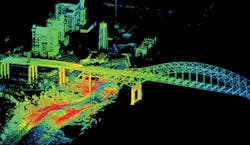WRIGHT-PATTERSON AFB, Ohio — Researchers at JASR Systems in Solana Beach, Calif., are developing chip-scale, lightweight, and affordable light detection and ranging (lidar) sensors for military 3-D mapping, foliage-penetrating electro-optical sensors, navigation, and long-range communications.
Officials of the U.S. Air Force Research Laboratory at Wright-Patterson Air Force Base, Ohio, have announced an $8.2 million contract to JASR to develop chip-scale optical phased arrays and lidar systems that use technology from the Modular Optical Aperture Building Blocks (MOABB) project of the U.S. Defense Advanced Research Projects Agency (DARPA) in Arlington, Va.
The DARPA MOABB project, begun in late 2015, developed enabling technologies for affordable chip-scale lidar sensors using free-space optical technology with ultra-low size, weight, and cost with much faster beam scanning speeds than are typically available today.
The U.S. Air Force is working with JASR Systems to develop chip-scale, lightweight, and affordable light detection and ranging (lidar) sensors for military 3-D mapping, foliage-penetrating electro-optical sensors, navigation, and long-range communications.
The MOABB project aimed at developing and demonstrating enabling technologies for an integrated photonic device able to generate, amplify, transmit, and receive free-space optical radiation over a wide angle.
Companies involved in the DARPA MOABB sensors project are Lockheed Martin Coherent Technologies in Louisville, Colo.; TREX Enterprises Corp. in San Diego; Analog Photonics LLC in Hingham, Mass.; and Teledyne Scientific & Imaging LLC in Thousand Oaks, Calif.
With MOABB, DARPA researchers aimed at building planar, millimeter-scale transmit/receive units with a high fill factor aperture, non-mechanical beam steering, and integrated amplification.
Among the project’s goals was to fabricate a coherent 10-centimeter transmit/receive array with distributed gain built with wafer-scale processing, and demonstrate the coherent array in a packaged lidar system capable of 3-D imaging from as far away as 100 meters.
Free-space optical systems have tremendous potential for sensing, illumination, and communications, DARPA scientists say. The micron-scale wavelength allows for 0.001-degree angular resolution and antenna gain of more than 100 decibels from a modest 10-centimeter aperture.
The frequency in the hundreds of terahertz range and wide operating bandwidths enable high-speed data transmission and 3-D imaging with sub-millimeter range resolution.
Applications for these features span the space from 3-D mapping, foliage penetrating lidar, navigation, and long-range communications.
While free-space optical systems offer compelling capabilities, they are too big, heavy, and expensive for many applications. Above a 10-centimeter aperture, their size and weight are dominated by the bulky lenses, mirrors, stabilized mechanical components, and large volume of empty space of the telescope or imaging system.
On the other hand, aperture smaller than 10 centimeters still require bulky mechanical gimbals to steer the telescope and the back-end optics like lasers and detectors.
Instead, the MOABB project sought to capitalize on developments in integrated photonics that offer the potential for high-speed, non-mechanical beam-steering. Researchers believe that efficient sources, detectors, amplifiers, and low-loss waveguides can be fabricated on one planar platform for high-power, large scale apertures.
On this contract JASR will do the work in Solana Beach, Calif., and should be finished by November 2020.
For more information contact JASR Systems online at www.jasr.systems, or the Air Force Research Laboratory at www.wpafb.af.mil/afrl.

